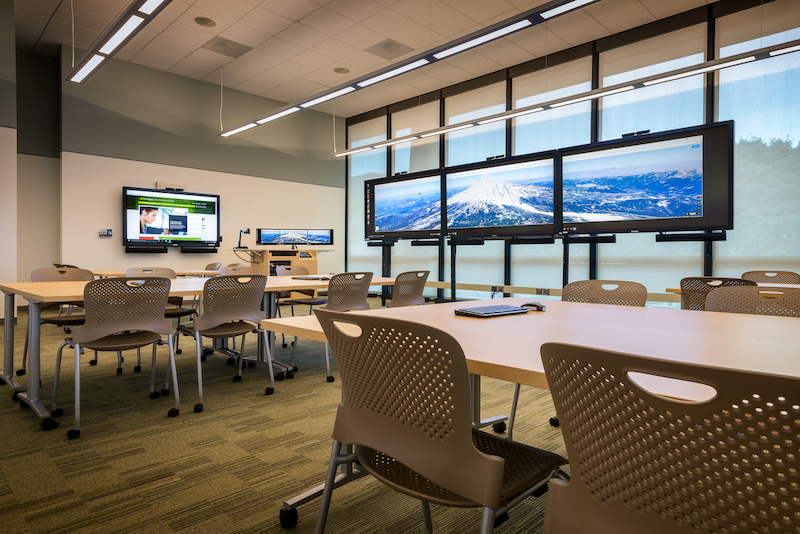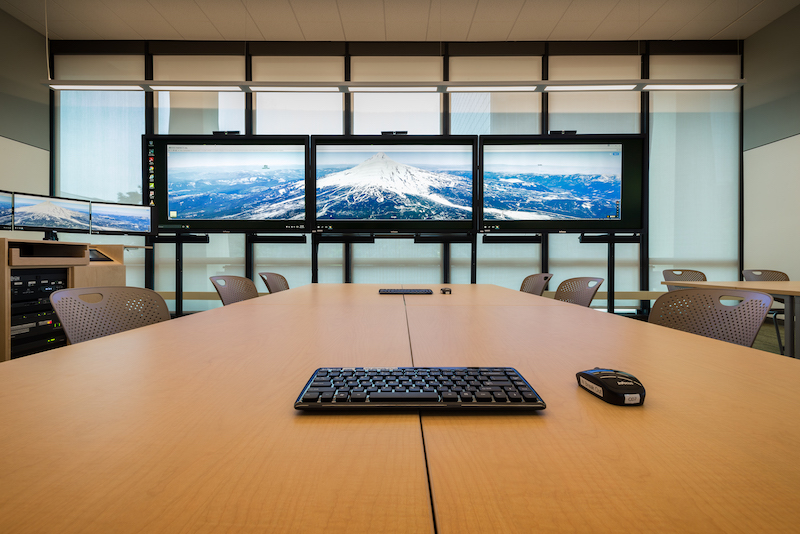Portland State University wanted to create a high-tech collaboration space for its students, researchers, and community stakeholders to come together. The space would be used to work on a variety of projects that link data sets, visualization, and decisions.
In order for the room to achieve its main purpose, it needed to have large visuals, powerful computing, robust video conferencing and a modular environment. The new space, dubbed the Decision Theater, originally was going to have a multi-panel video wall installed, but the concern was that the video wall would be great for large groups, but wouldn’t be conducive to individuals or small groups working separately in the room.
Eventually, PSU decided to use InFocus Mondopads to create the video wall because they can be used together to display one large image, but can also be used separately for smaller groups without losing any of their desired functions.
InFocus Mondopads, which are essentially large tablets, include features such as a touchscreen interface, camera, speaker bar, extensive connectivity, and the ability to be integrated into existing AV systems.
 Photo courtesy Portland State University.
Photo courtesy Portland State University.
In total, PSU used seven Mondopads in the Decision Theater. Three 1080p 80-inch Mondopads are tiled across the front of the room with the ability to display multiple smaller images or one giant image. Another four 1080p 70-inch Mondopads were placed on the remaining three walls to create group huddle spaces. The three 80-inch Mondopads at the front of the classroom can also be broken apart to create seven separate all-in-one displays.
Each Mondopad has a multi-touch high definition display and comes with a built-in Windows PC and a full version of Microsoft Office. The large screen can also become a digital interactive whiteboard, has document annotation, and allows users to share, view, and control the screen from a tablet or smartphone.
Business-class video conferencing allows PSU students and researchers to connect with individuals across the country. While on a video call, the work being presented, such as design plans, can be drawn on top of and annotated.
The full Mondopad product line stretches from 57-inch screens up to 85-inch screens.
 Photo courtesy Portland State University.
Photo courtesy Portland State University.
Related Stories
| Aug 11, 2010
ASHRAE Receives NIST Grant to Study IAQ in Retail Stores
The American Society of Heating Refrigeration and Air-conditioning Engineers (ASHRAE) has been awarded $1.5 million dollars in grant money from the National Institute of Standards and Technology (NIST) to conduct a three-year research project on ventilation and indoor air quality in retail stores.
| Aug 11, 2010
Georgia Tech requires LEED Gold for all new buildings and renovations
The Georgia Institute of Technology in Atlanta is currently updating its facilities design standards to meet LEED (Leadership in Energy and Environmental Design) Gold as set by the U.S. Green Building Council. Energy Ace, Inc., an Atlanta-based sustainability consulting firm is assisting Georgia Tech in preparing the Standards upgrade.
| Aug 11, 2010
UC Merced researchers receive $568,000 grant to develop solar sensing, tracking system
Alberto Cerpa, an engineering professor at the University of California Merced, has received a $568,202 grant from the National Science Foundation to develop a system that will measure and track the amount of sunlight that reaches ground level where photovoltaic panels and solar concentrators used in solar energy systems collect light and heat to turn into electricity.
| Aug 11, 2010
Mark McCracken named chair-elect of USGBC Board of Directors
Mark MacCracken, CEO of CALMAC, Inc., a producer of cold storage energy solutions, has been selected as Chair-elect of the U.S. Green Building Council (USGBC) Board of Directors for the 2010 calendar year. The USGBC Board of Directors is responsible for articulating and upholding the vision, values and mission of USGBC. In 2009, MacCracken was elected to serve a second 3-year term as Director in the Energy Services Seat.
| Aug 11, 2010
Only four out of 337 cities added construction jobs in 2009
Construction employment grew in only four out of 337 metropolitan areas in 2009 as spending on construction projects dropped by $100 billion in December to a six-year low of $903 billion, according to a new analysis by the Associated General Contractors of America of federal figures released recently.
| Aug 11, 2010
Zero Energy Buildings + Homes' Call for Editorial Contributions & Contributors
BD+C will publish its 8th Annual White Paper on Green Buildings, "Zero Energy Buildings + Homes," in November-and you can contribute to it. We're looking for highly qualified experts (or teams of experts) to write individual chapters (about 2,000-3,000 words). We've started the outline here, but we'd like your suggestions about additional chapters. What did we miss? Help us shape this important report.
| Aug 11, 2010
Blue ribbon panel unveils recommendations for NYC's green building codes
In response to City's request, the task force unveils more than 100 recommendations for greening NYC buildings, in most sophisticated analysis ever conducted by a municipality
| Aug 11, 2010
ULI: 'Old Normal' will not be a part of the housing recovery
As the U.S. economy recovers, emerging trends in demographics and consumer behavior will become major drivers of new housing opportunities, resulting in a residential market vastly different from the one that existed prior to the recession, according to Housing in America: The Next Decade, a new research paper authored by John K. McIlwain, senior resident fellow, Urban Land Institute/J. Ronald Terwilliger Chair for Housing.
| Aug 11, 2010
Billings increase less than a point in December, still in negative territory
The American Institute of Architects reported the December Architecture Billings Index rating was 43.4, up slightly from 42.8 in November. The score indicates a continued decline in demand for design services (any score above 50 indicates an increase in billings). AIA Chief Economist Kermit Baker said the inability to get financing is still the main roadblock to recovery.
| Aug 11, 2010
FMI: 2009 was the bottom for residential, non-residential construction still in freefall
While 2009 was likely the bottom in terms of percentage decline, 2010 will be the bottom in terms of dollar volume for non-residential construction, according to market analysts at consulting firm FMI. Residential construction is expected to begin recovering in 2010. The economy may show some signs of improving, but it is just the beginning of the downfall for nonresidential construction.







